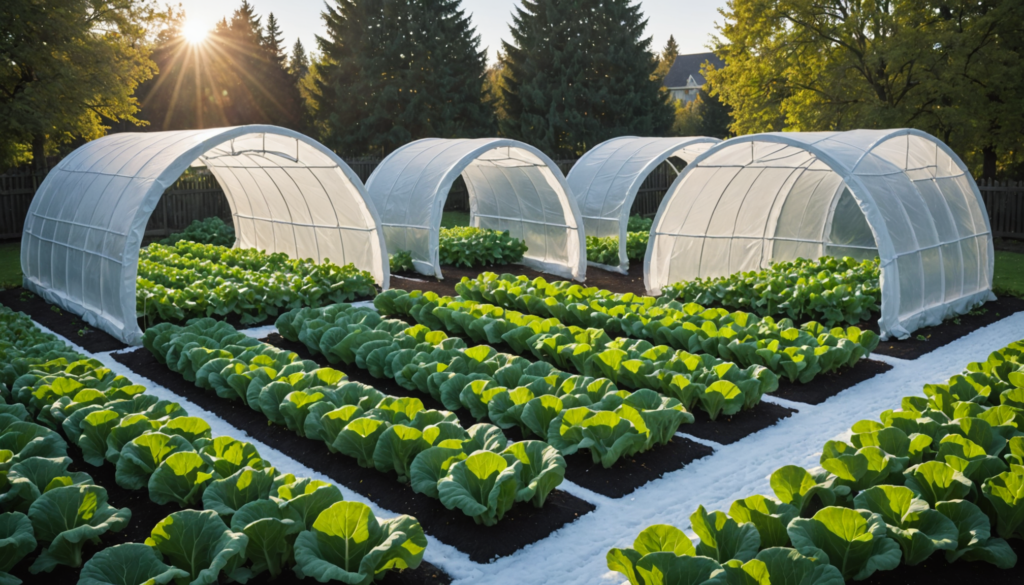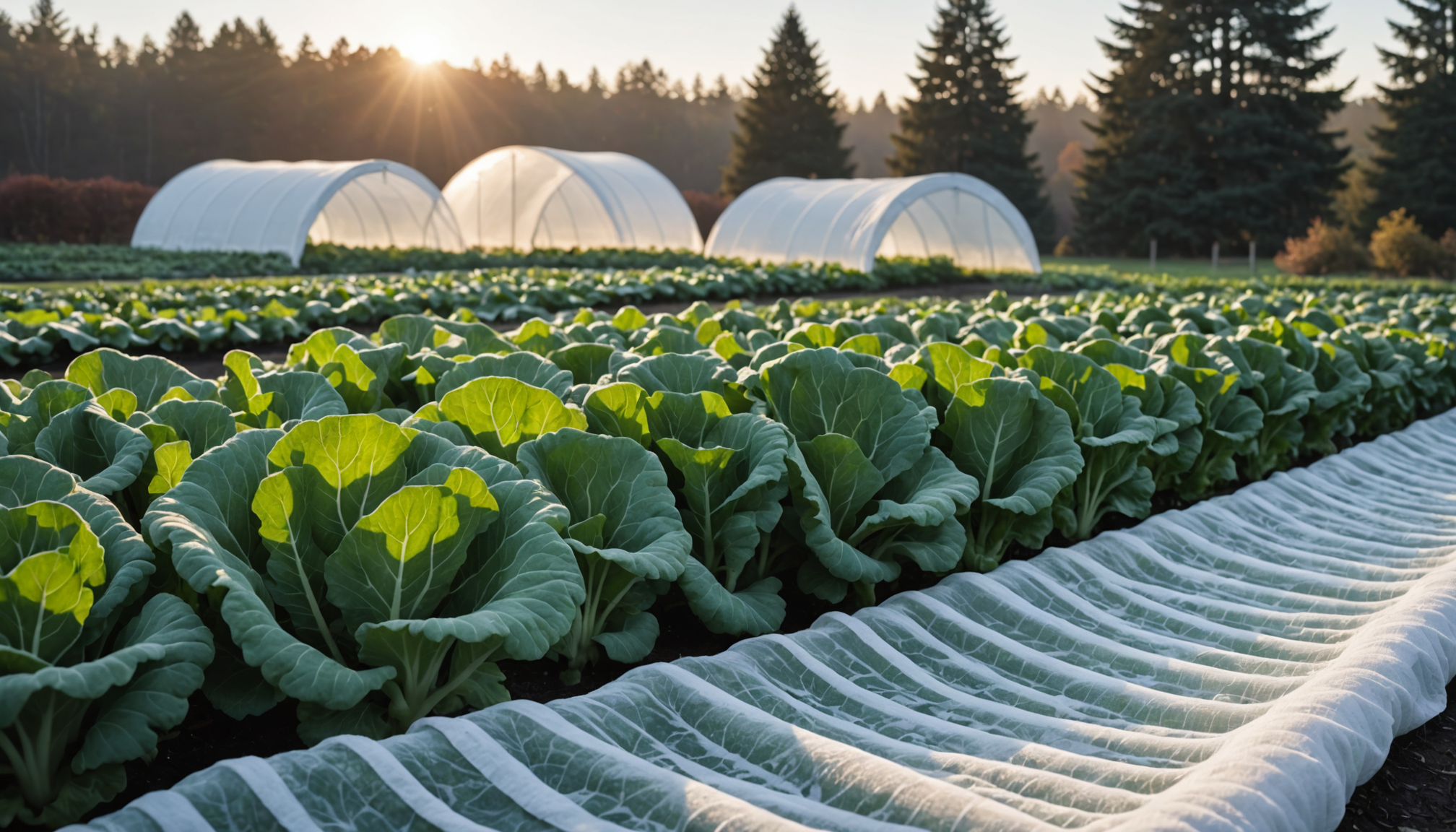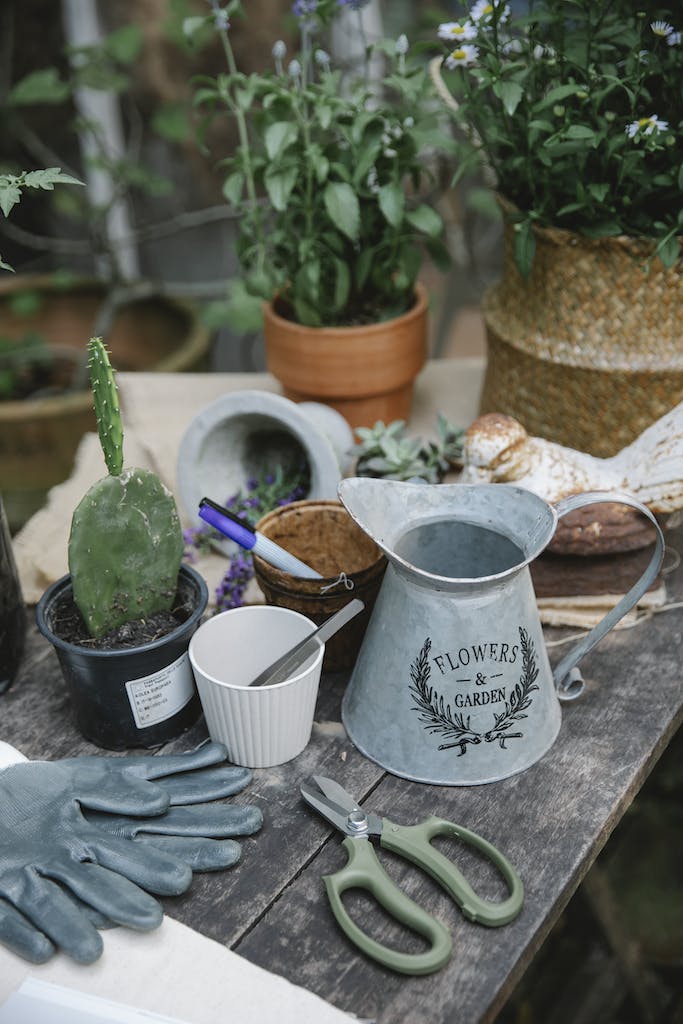When winter’s icy grip threatens your precious garden, learning how to cover plants with frost cloth becomes your secret weapon against crop damage. This lightweight, breathable fabric creates a protective shield that can mean the difference between a thriving garden and withered, frost-damaged plants. Even a single freezing night can destroy weeks of careful gardening work, making frost protection essential for every vegetable garden.
Whether you’re growing tender tomatoes or delicate lettuce, frost cloth provides the perfect balance of protection and plant care. We’ll explore the best techniques for using frost blankets, from proper installation methods to creating protective tunnels with garden hoops. You’ll discover how this simple garden tool can extend your growing season and keep your plants safe during unexpected cold snaps. Get ready to transform your garden into a frost-resistant haven where your vegetables can flourish even when temperatures drop!
How to Cover Plants with Frost Cloth

What is Frost Cloth and Why Use It?
I rely on frost cloth, often called row cover, to shield plants from cold air temperatures. It’s made from spunbonded polypropylene and allows about 70–85% of sunlight to pass through while keeping frost out (Wikipedia). The fabric also breathes, so it helps maintain proper airflow around leaves. I choose a weight between 0.5 oz/sq yd and 2.0+ oz/sq yd based on how severe the frost might be.
Best Types of Frost Protection Products
I turn to lightweight frost cloth (0.5-1.0 oz/sq yd.) for mild chills and medium-weight (1.5 oz/sq yd.) fabric for routine cold snaps. When the danger of frost is higher, I prefer a 2.5 oz/sq yd fabric, which is a heavier weight option that handles strong winds and freeze damage better. In some cases, heavy-duty covers (2.0+ oz.) give extra protection for frost-tender plants like tomato or bell pepper plants.
Understanding the Benefits of Frost Blankets
When I keep actual frost cloth in place, I see fewer frost-damaged plants and less leaf curling from chilly night air. This barrier traps warmth around delicate crops with frost cloth, such as spinach or cabbage, without blocking vital sunlight. It also reduces cold winds, helps keep the soil moist, and supports an earlier spring and fall planting season (Frostfabric, Fabricpros).
Cost Comparison of Different Frost Protection Methods
Basic row covers usually cost $0.10–$0.30 per square foot and last about one or two seasons. Professional-grade products, priced at $0.40–$0.80 per square foot, remain durable for 2–4 seasons if I store them properly. I secure these breathable fabrics with clamps or bricks to prevent damage from wind, and I remove them once the average temperature climbs above freezing.
Colorado State University Extension and Texas A&M AgriLife Extension offer more details on protecting plants from frost.
Effective Techniques to Protect Plants from Frost

How to Properly Use Frost Cloth for the Garden
I place actual frost cloth around plants before the temperature drops below 32°F. Though 2.5 oz/sq yd.–this mid-weight fabric option works well in colder climates. I secure the cloth at ground level to form a barrier against frost and trap radiant heat. A loose drape gives plants room to move while still offering protection.
Building a Hoop or Low Tunnel for Additional Protection
I create hoops with flexible agricultural wire or PVC pipe, keeping the arch 12 to 24 inches above the tallest foliage. This space prevents direct contact, reduces frost-damaged plants, and allows air circulation underneath. I place the hoops every 4 to 6 feet, then cover them with frost cloth to hold warmth overnight. Each tunnel shields my autumn garden from cold snaps and strong winds.
Benefits of Using Row Covers for Vegetables
Row covers provide 4 to 8°F of protection and help me maintain more stable air temperatures for tender plants, such as lettuce or bell pepper plants. They also allow about 70% or more sunlight through while preventing sudden temperature changes. I find these covers reduce wind damage and keep the soil moist. As a result, I see healthier growth and fewer frost-damaged plants.
Step-by-Step Installation Guide
I install hoops or other supports first, then cut the frost cloth about 10% longer than needed. I drape it loosely over the structure and anchor the edges with pins, soil, or bricks. This setup preserves warmth and allows me to lift sections for watering or adding additional heat sources. I monitor air temperatures beneath the cloth daily to ensure proper ventilation and minimize damage from frost.
DIY Methods for Frost Protection

Protecting delicate plants from cold does not require costly supplies. Many gardeners learn how to cover plants with frost cloth or other breathable fabrics to shield crops from chilly night air. These simple techniques block cold wind, trap heat radiating from the ground, and reduce the chance of frost-damaged plants.
While dedicated frost cloth provides the most reliable protection, here are some DIY alternatives for light frosts.
Creating Your Own Frost Blanket
Old bedsheets, lightweight blankets, and breathable polyester fabric work well as frost blankets. Clean covers let moisture escape while keeping cold air away. Place them over plants before sundown and remove them in the morning. Garden stakes, PVC hoops, or tomato cages help keep the cover in place without crushing leaves. Multiple fabric layers offer extra insulation during a light frost.
Innovative Ways to Protect Vegetable Gardens
Simple cloches and row covers can block cold winds and keep soil warmer for cool-season crops. One-gallon milk jugs with the bottoms removed act like mini greenhouses for seedlings. These jugs trap heat while allowing air circulation through the open cap. Row cover tunnels use PVC hoops and plastic sheets to create a breathable barrier. Burying the edges with soil or garden staples for a secure seal against cold night air.
Utilizing Mini Greenhouses for Early Spring Planting
Recycled materials such as clear storage bins and old window frames also safeguard plants when temperatures drop. These small enclosures raise interior air temperatures by several degrees. They need simple vents at the top to prevent excess humidity build-up. Panels made of glass or plastic sheeting provide extra insulation for crops like lettuce or spinach.
| Material | Protection Level | Best For |
|---|---|---|
| Clear storage bins | Moderate | Small seedlings |
| Window frames | High | Tender transplants |
| Plastic sheeting | Light | Row crops |
| Glass panels | Maximum | Frost-sensitive plants |
Recycling Materials for Frost Protection
Cardboard boxes and bubble wrap shield plants from a light freeze and help trap ground heat. These items keep temperatures 4°F higher inside the enclosure. Bricks or stones along edges secure covers in place while preventing damage to roots. Removing covers each morning decreases the risk of fungal issues by allowing fresh air circulation.
These DIY strategies often provide enough insulation for frosts between 28°F and 32°F. They help protect plants without major investment and encourage a longer growing season for many vegetables.
Risks and Considerations in Frost Damage

Common Mistakes When Covering Plants
I see many frost-damaged plants when people let protective cloth touch delicate leaves. That direct contact transfers cold and harms tissues. I also notice late coverings installed after sunset, which lose precious ground heat. Loose edges allow frigid air to sneak inside, and removing covers too early often exposes plants to a lingering chill.
How to Avoid Frost Damage in Your Vegetable Garden
For very tender plants, especially in areas with prolonged cold snaps, begin protection when temperatures dip below 40°F (4°C). However, for most plants, frost cloth application is crucial when temperatures approach 32°F (0°C).
I drape actual frost cloth so it extends to the ground, creating a barrier against frost while trapping warm air. I also water the soil in advance because moist ground stays warm longer than dry soil. In my view, tent-like frames keep cloth off foliage, reducing cold spots and damage from direct contact.
Plant Protection Temperature Guide:
| Plant Type | Critical Temperature | Protection Priority |
|---|---|---|
| Tender | 32°F (0°C) | High |
| Semi-Hardy | 28-32°F (-2 to 0°C) | Medium |
| Hardy | Below 28°F (-2°C) | Low |
The Importance of Timing for Frost Protection
I prefer to install frost cloth 2-3 hours before sunset. This step traps daytime heat and shields plants from a chilly night. Uncover plants when daytime temperatures consistently rise above 32°F (0°C) and the risk of further frost has passed. For optimal results, wait until temperatures reach closer to 40-50F(4-10C). I also check weather forecasts for wind and length of any cold snap to plan coverage duration.
Identifying Frost-Sensitive Plants
I focus on peppers, tomatoes, cucumbers, basil, eggplants, and other tender plants during a frost event. Their leaves often turn soft and water-soaked, then collapse under cold stress. Dark or brown spots mean the plant’s tissues have frozen. I group these sensitive plants together and keep lightweight frost cloth in place when the danger of frost is high.
Expert Recommendations: Best Practices for Frost Protection

How to Extend My Growing Season with Frost Cloth
I place frost cloth over delicate plants before temperatures drop below 32°F. This lightweight barrier helps trap heat and protect tender crops from frost damage. I also leave 18–24 inches of slack so the plants can continue growing underneath. Removing the cover on warmer days prevents overheating and keeps plants healthier.
Finding the Right Frost Cloth to Buy
I look for materials ranging from 0.5 oz/sq yd to 2.0+ oz/sq yd, choosing the weight based on the expected severity of frost. Lighter options offer mild coverage, while heavier fabrics protect against severe cold snaps. I prefer UV-resistant frost cloth because it lasts longer and can be reused. Selecting a mid-weight fabric (around 1.5 oz) adds extra protection without restricting airflow.
Seasonal Maintenance Tips
I wash frost blankets in cool water and let them dry completely before storing. Regular inspections reveal small tears that I patch or replace to avoid future damage. Rolling the cloth, instead of folding, reduces creases that weaken fibers. Proper storage in a dry area extends the cloth’s lifespan.
Professional Gardeners’ Success Stories
I have seen growers extend their harvests by an extra two to four weeks, thanks to proper frost cloth coverage. Consistent use of frost cloth has been shown to significantly reduce crop losses due to frost. Planning ahead and tracking weather forecasts are key steps. Multiple layers offer the best results during harsh, cold nights.
Conclusion
Protecting your vegetable garden from frost damage is easier than you might think with the right tools and techniques. Frost cloth is an excellent investment that can shield your precious plants from cold temperatures while still allowing them to receive sunlight and air. Whether you choose to use simple draping methods or create a more permanent solution with hoops and tunnels, the key is to act before the frost arrives.
Remember that proper timing and careful installation of your frost protection system can make all the difference in keeping your garden thriving through cold snaps. From delicate seedlings to mature vegetables, every plant can benefit from this added layer of protection. With these frost protection methods in your gardening toolkit, you can extend your growing season and enjoy fresh vegetables even when temperatures drop!
FAQs
1. How long can frost cloth remain on plants?
Frost cloth can stay on plants for several days during cold nights. However, it should be removed once daytime temperatures consistently rise above 32°F (0°C), and ideally when they approach 40-50F (4-10C) to prevent overheating.
2. Does frost cloth allow water and light to pass through?
High-quality, lightweight frost cloth allows approximately 70% of sunlight through and permits water to seep in, keeping the soil moist and supporting plant growth.
3. How much cold protection does frost cloth offer?
Most frost cloth provides 4–8°F of frost protection, making it effective during light freezes.
4. How can I prevent contact damage when using frost cloth?
Use stakes or hoops to ensure the fabric does not touch the leaves. This prevents frost-damaged plants and protects delicate petals.
5. How do I prevent wind displacement of frost cloth?
Secure the edges of the frost cloth with pins or heavy items. Overlap any seams by 4–6 inches to create a sturdy barrier against frost and strong winds.







